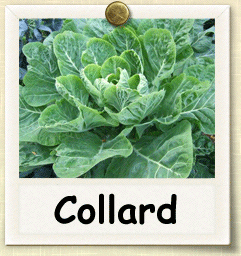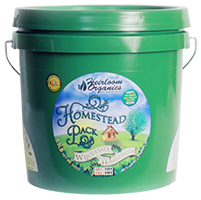|
Home > Guides > Vegetables > Collard |
|
How to Grow Collard | Guide to Growing Collard |
|
|
|
|
| |
 |
|
Overview |
|
|
|
|
|
| |
|
| |
The flavor of this traditional Southern potherb is improved by frost. Very cold hardy (harvest can continue right through snow), collards are also among the most heat tolerant of cole crops. |
|
| |
|
|
| |
Growing Guide
GROWING NOTES
Prefers full sun in spring, but can benefit from light shade during hot weather.
Prefers well-drained, fertile soil high in organic matter, pH 6.0 to 7.5. Can tolerate slightly alkaline soil. Prefers plentiful, consistent moisture. Can tolerate drought, but quality and flavor of leaves suffer.
Biennial grown as an annual.
Some varieties have blue-green cast.
As plants mature and lower leaves are harvested, plants begin to look less like a clump and start to resemble small palm trees with a cluster of leaves at the top of a long stem.
MAINTAINING
Direct seed about three months before expected fall frost. Plant seeds ¼ to ½ inch deep, 1 inch apart in rows 18 to 30 inches apart. Thin to 12- to 18-inch spacings. Eat or transplant thinnings.
For spring crops, start plants inside about 8 weeks before the last frost, and transplant when they are about 6 weeks old. Set transplants 12 inches apart, rows 18 to 24 inches apart.
Plant direct-seeded crops 1/2 inch deep and 3 inches apart 3 weeks before last frost. Thin to 12 to 18 inches apart.
Mulch overwintering plants.
Collards don't seem to be as troubled by pests as most other cole crops. Use floating row covers to help protect from early insect infestations.
To help reduce disease, do not plant collards or other cole crops in the same location more than once every three or four years.
|
|
| |
|
| |
Heirloom seeds are the gardeners choice for seed-saving from year-to-year. Learning to save seeds is easy and fun with these books. Before you harvest, consider which varieties you might want to save seeds from so that your harvesting practice includes plants chosen for seed saving. Be sure to check out our newest seed packs, available now from Heirloom Organics. The Super Food Garden is the most nutrient dense garden you can build and everything you need is right here in one pack. The Genesis Garden s a very popular Bible Garden collection. The Three Sisters Garden was the first example of companion planting in Native American culture. See all of our brand-new seed pack offerings in our store.
|
|
| |
|
|
| |
Harvesting Guide
HARVESTING
All green parts of the plant are edible and may be harvested at any time during the growing season. Plants grown 6 inches apart can be cut at ground level when they reach 6 to 10 inches in height. As an alternative method of harvesting, you can pick the large leaves when the plants are 10 to 12 inches high.
This harvesting method allows the younger leaves to develop for later use. Some gardeners prefer the young, tender leaves and cut the inner rosette of young growth. This "loose head" may be blanched by tying the outer leaves together to keep out the sun. Frost improves the flavor in the fall
SAVING SEEDS
If you want to save the seeds from your collard greens, just leave some of the flowering plants alone to form seed pods. You'll be able to identify them easily once they form because they look almost like green beans. In fact, some people even eat them. The pods can be left to dry right on the plant in the same way you would leave bean pods to dry. Once dry, store them in a paper bag until you plant them. Cutting off the stem of the plant while it's blooming and planting it won't work. Collard greens are best grown from seed or by purchasing seedlings inexpensively from a nursery. |
|
| |
|
|
|
| |
|
|
|
|
|
| You can find this variety in the following Seed Packs: |
|
  

|
|
| Click the packs below to see some of our other wonderful products |
|
|
|
|
|
|
|